Vulnerability Analysis of Urban Drainage Systems: Tree vs. Loop Networks
Abstract
:1. Introduction
2. Methodology
2.1. Hydrodynamic Simulations
2.2. Vulnerability Index Calculation
3. Case Study
3.1. Case Study Networks
3.2. Model Inputs and Parameters
3.3. Cost of the Pipes and Tanks
4. Results and Discussion
4.1. Vulnerability of Tree and Loop Network Systems
4.1.1. Tree Network Systems
4.1.2. Loop Network Systems
4.1.3. Comparison between Tree and Loop Networks
4.2. The Impacts of Adaptation Measures
4.2.1. Converting Tree Network Systems into Loop Systems
4.2.2. Vulnerability Comparison of Systems before and after Upgrading into Loop Systems
4.2.3. Storage Tank Provision
5. Conclusions
Acknowledgments
Author Contributions
Conflicts of Interest
References
- Karamouz, M.; Nazif, S. Reliability-Based Flood Management in Urban Watersheds Considering Climate Change Impacts. J. Water Resour. Plan. Manag. 2013, 139, 520–533. [Google Scholar] [CrossRef]
- Ana, E.; Bauwens, W. Modeling the structural deterioration of urban drainage pipes: The state-of-the-art in statistical methods. Urban Water J. 2010, 7, 47–59. [Google Scholar] [CrossRef]
- Hahn, M.A.; Palmer, R.N.; Merrill, M.S.; Lukas, A.B. Expert system for prioritizing the inspection of sewers: Knowledge base formulation and evaluation. J. Water Resour. Plan. Manag. 2002, 128, 121–129. [Google Scholar] [CrossRef]
- Fu, G.; Butler, D. Copula-based frequency analysis of overflow and flooding in urban drainage systems. J. Hydrol. 2014, 510, 49–58. [Google Scholar] [CrossRef] [Green Version]
- Fu, G.; Butler, D.; Khu, S.T.; Sun, S.A. Imprecise probabilistic evaluation of sewer flooding in urban drainage systems using random set theory. Water Resour. Res. 2011, 47. [Google Scholar] [CrossRef] [Green Version]
- Meng, F.; Fu, G.; Butler, D. Water quality permitting: From end-of-pipe to operational strategies. Water Res. 2016, 101, 114–126. [Google Scholar] [CrossRef] [PubMed] [Green Version]
- Timmerman, P. Vulnerability, Resilience and the Collapse of Society: A Review of Models and Possible Climatic Applications; Institute for Environmental Studies, University of Toronto: Toronto, ON, Canada, 1981. [Google Scholar]
- Li, H.; Zhang, P.; Cheng, Y. Concepts and Assessment Methods of Vulnerability. Prog. Geogr. 2008, 27, 18–25. [Google Scholar]
- Liverman, D.M. Vulnerability to Global Environmental Change. Understanding Global Environmental Change: The Contributions of Risk Analysis and Management; Clark University: Worcester, MA, USA, 1990; pp. 27–44. [Google Scholar]
- Füssel, H.-M.; Klein, R.J. Climate change vulnerability assessments: An evolution of conceptual thinking. Clim. Chang. 2006, 75, 301–329. [Google Scholar] [CrossRef]
- Davidson, R.A.; Shah, H.C. An Urban Earthquake Disaster Risk Index; Stanford University: Stanford, CA, USA, 1997. [Google Scholar]
- Turvey, R. Vulnerability assessment of developing countries: The case of small-island developing states. Dev. Policy Rev. 2007, 25, 243–264. [Google Scholar] [CrossRef]
- Metzger, M.J.; Leemans, R.; Schröter, D. A multidisciplinary multi-scale framework for assessing vulnerabilities to global change. Int. J. Appl. Earth Obs. Geoinf. 2005, 7, 253–267. [Google Scholar] [CrossRef]
- Ezell, B.C.; Farr, J.V.; Wiese, I. Infrastructure risk analysis of municipal water distribution system. J. Infrastruct. Syst. 2000, 6, 118–122. [Google Scholar] [CrossRef]
- McCarthy, J.J. Climate Change 2001: Impacts, Adaptation, and Vulnerability: Contribution of Working Group II to the Third Assessment Report of the Intergovernmental Panel on Climate Change; Cambridge University Press: Cambridge, UK, 2001. [Google Scholar]
- White, G.F. Natural Hazards, Local, National, Global; Oxford University Press: Oxford, UK, 1974. [Google Scholar]
- Vogel, C. Vulnerability and global environmental change. LUCC Newsl. 1998, 3, 15–19. [Google Scholar]
- Cutter, S.L.; Boruff, B.J.; Shirley, W.L. Social vulnerability to environmental hazards. Soc. Sci. Q. 2003, 84, 242–261. [Google Scholar] [CrossRef]
- Ezell, B.C. Infrastructure Vulnerability Assessment Model (I-VAM). Risk Anal. 2007, 27, 571–583. [Google Scholar] [CrossRef] [PubMed]
- Kanta, L.R. Vulnerability Assessment of Water Supply Systems for Insufficient Fire Flows; Texas A&M University: College Station, TX, USA, 2006. [Google Scholar]
- Ezell, B.C. Toward a systems-based vulnerability assessment methodology for water supply systems. In Proceedings of the 10th United Engineering Foundation Conference, Santa Barbara, CA, USA, 3–8 November 2002.
- Xin, K.; Tao, T.; Wang, Y.; Liu, S. Hazard and vulnerability evaluation of water distribution system in cases of contamination intrusion accidents. Front. Environ. Sci. Eng. 2012, 6, 839–848. [Google Scholar] [CrossRef]
- Yazdani, A.; Jeffrey, P. A complex network approach to robustness and vulnerability of spatially organized water distribution networks. arXiv 2010. [Google Scholar]
- Shuang, Q.; Zhang, M.; Yuan, Y. Node vulnerability of water distribution networks under cascading failures. Reliab. Eng. Syst. Saf. 2014, 124, 132–141. [Google Scholar] [CrossRef]
- Kanta, L.; Brumbelow, K. Vulnerability, risk, and mitigation assessment of water distribution systems for insufficient fire flows. J. Water Resour. Plan. Manag. 2012, 139, 593–603. [Google Scholar] [CrossRef]
- Murray, R.; Janke, R.; Uber, J. The threat ensemble vulnerability assessment (TEVA) program for drinking water distribution system security. In Proceedings of the World Water and Environmental Resources Congress, Marrakech, Morocco, 20–24 September 2004.
- Tidwell, V.C.; Silva, C.J.; Jurado, S. An integrated approach to vulnerability assessment. In Proceedings of the Impacts of Global Climate Change (ASCE), Anchorage, AK, USA, 15–19 May 2005.
- Jaeger, C.D.; Hightower, M.M.; Torres, T. Evolution of Sandia’s Risk Assessment Methodology for Water and Wastewater Utilities (RAM-W). In Proceedings of the World Environmental and Water Resources Congress 2010@ Challenges of Change (ASCE), Providence, RI, USA, 16–20 May 2010.
- Shao, C.-Q. Vulnerability Assessment Model for Critical Infrastructure—Tianjin Water Distribution System Case Study; Nankai University: Tianjin, China, 2009. [Google Scholar]
- Li, H.-B. Study on Vulnerability Analysis of Urban Water Supply System; Tianjin University: Tianjin, China, 2009. [Google Scholar]
- Pinto, J.; Varum, H.; Bentes, I.; Agarwal, J. A theory of vulnerability of water pipe network (TVWPN). Water Resour. Manag. 2010, 24, 4237–4254. [Google Scholar] [CrossRef]
- Moderl, M.; Kleidorfer, M.; Sitzenfrei, R.; Rauch, W. Identifying weak points of urban drainage systems by means of VulNetUD. Water Sci. Technol. 2009, 60, 2507–2513. [Google Scholar] [CrossRef] [PubMed]
- Poulter, B.; Goodall, J.L.; Halpin, P.N. Applications of network analysis for adaptive management of artificial drainage systems in landscapes vulnerable to sea level rise. J. Hydrol. 2008, 357, 207–217. [Google Scholar] [CrossRef]
- Möderl, M.; Sitzenfrei, R.; Lammel, J.; Apperl, M.; Kleidorfer, M.; Rauch, W. Development of an urban drainage safety plan concept based on spatial risk assessment. Struct. Infrastruct. Eng. 2015, 11, 918–928. [Google Scholar] [CrossRef]
- Friedrich, E.; Kretzinger, D. Vulnerability of wastewater infrastructure of coastal cities to sea level rise: A South African case study. Water SA 2012, 38, 755–764. [Google Scholar] [CrossRef]
- Kleidorfer, M.; Moderl, M.; Sitzenfrei, R.; Urich, C.; Rauch, W. A case independent approach on the impact of climate change effects on combined sewer system performance. Water Sci. Technol. 2009, 60, 1555–1564. [Google Scholar] [CrossRef] [PubMed]
- Sitzenfrei, R.; Mair, M.; Moderl, M.; Rauch, W. Cascade vulnerability for risk analysis of water infrastructure. Water Sci. Technol. 2011, 64, 1885–1891. [Google Scholar] [CrossRef] [PubMed]
- Mair, M.; Sitzenfrei, R.; Kleidorfer, M.; Moderl, M.; Rauch, W. GIS-based applications of sensitivity analysis for sewer models. Water Sci. Technol. 2012, 65, 1215–1222. [Google Scholar] [CrossRef] [PubMed]
- Hou, Q. Study on Vulnerability Assessment and Emergency Measures of Storm Sewer Syetem; Qingdao Technological University: Qingdao, China, 2014. [Google Scholar]
- Mugume, S.N.; Gomez, D.E.; Fu, G.; Farmani, R.; Butler, D. A global analysis approach for investigating structural resilience in urban drainage systems. Water Res. 2015, 81, 15–26. [Google Scholar] [CrossRef] [PubMed] [Green Version]
- Hao, L.; Cuimei, L. Vulnerability assessment of urban storm sewer systems. J. Shenzhen Univ. Sci. Eng. 2014, 6, 006. [Google Scholar]
- Seo, Y.; Seo, Y.-H.; Kim, Y.-O. Behavior of a Fully-Looped Drainage Network and the Corresponding Dendritic Networks. Water 2015, 7, 1291–1305. [Google Scholar] [CrossRef]
- Ji, Z. General hydrodynamic model for sewer/channel network systems. J. Hydraul. Eng. 1998, 124, 307–315. [Google Scholar] [CrossRef]
- Feng, L. Study on the Hydrodynamic and Wastewater Quality Transfonrmtion Model in Urban Sewer Networks; Dalian University of Technology: Dalian, China, 2009. [Google Scholar]
- Rossman, L.A. Storm Water Management Model User’s Manual, Version 5.0. Available online: http://www.owp.csus.edu/LIDTool/Content/PDF/SWMM5Manual.pdf (accessed on 23 February 2017).
- Peterson, E.W.; Wicks, C.M. Assessing the importance of conduit geometry and physical parameters in karst systems using the storm water management model (SWMM). J. Hydrol. 2006, 329, 294–305. [Google Scholar] [CrossRef]
- Tsihrintzis, V.A.; Hamid, R. Runoff quality prediction from small urban catchments using SWMM. Hydrol. Process. 1998, 12, 311–329. [Google Scholar] [CrossRef]
- Cong, X.-Y.; Ni, G.-H.; Hui, S.-B.; Tian, F.-Q.; Zhang, T. Simulative analysis on storm flood in typical urban region of Beijing based on SWMM. Water Resour. Hydropower Eng. 2006, 4, 64–67. [Google Scholar]
- Zhao, D.-Q.; Chen, J.-N.; Tong, Q.-Y.; Wang, H.-Z.; Cao, S.-B.; Sheng, Z. Construction of SWMM urban drainage network model Based on GIS. China Water Wastewater 2008, 24, 88. [Google Scholar]
- Fu, G.; Kapelan, Z. Flood analysis of urban drainage systems: Probabilistic dependence structure of rainfall characteristics and fuzzy model parameters. J. Hydroinform. 2013, 15, 687–699. [Google Scholar] [CrossRef]
- Sun, S.; Fu, G.; Djordjević, S.; Khu, S.-T. Separating aleatory and epistemic uncertainties: Probabilistic sewer flooding evaluation using probability box. J. Hydrol. 2012, 420, 360–372. [Google Scholar] [CrossRef]
- Li, Y.; Wang, Y.; Zhang, H.; Zhang, C.; Cheng, M.; Yu, Z. Impact of Urbanization Process on Drainage System and Modification Measures Analysis. J. Water Resour. Res. 2015, 4, 273. [Google Scholar] [CrossRef]
- Tao, T.; Wang, J.; Xin, K.; Li, S. Multi-objective optimal layout of distributed storm-water detention. Int. J. Environ. Sci. Technol. 2014, 11, 1473–1480. [Google Scholar] [CrossRef]
- Keifer, C.J.; Chu, H.H. Synthetic storm pattern for drainage design. J. Hydraul. Divis. 1957, 83, 1–25. [Google Scholar]
- Marsalek, J.; Watt, W. Design storms for urban drainage design. Can. J. Civ. Eng. 1984, 11, 574–584. [Google Scholar] [CrossRef]
- Dong, Y. The Study on Optimal Design to Rehabilitation and Extension of Drainage Pipe Network; Xi’an University of Technology: Xi’an, China, 2006. [Google Scholar]

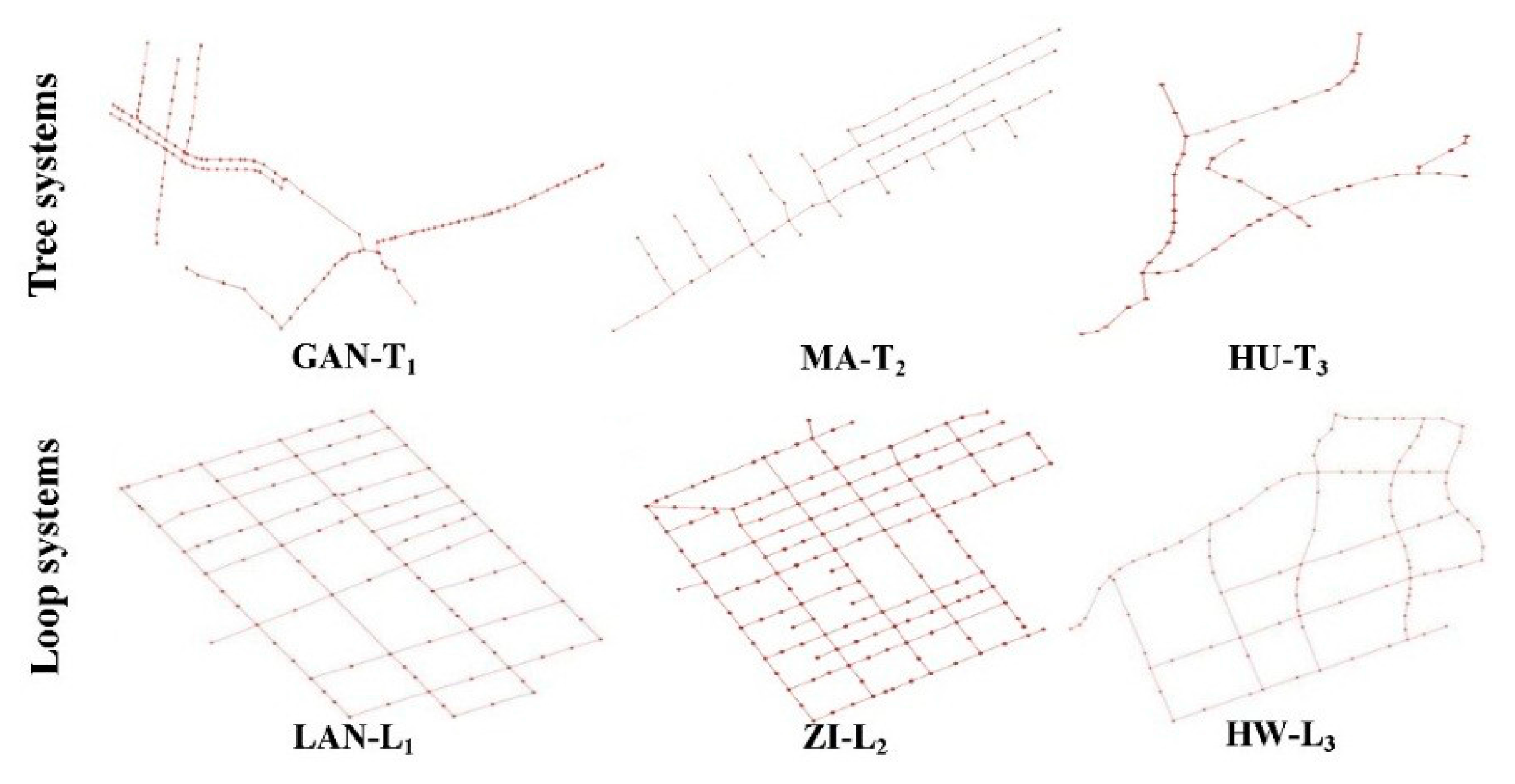
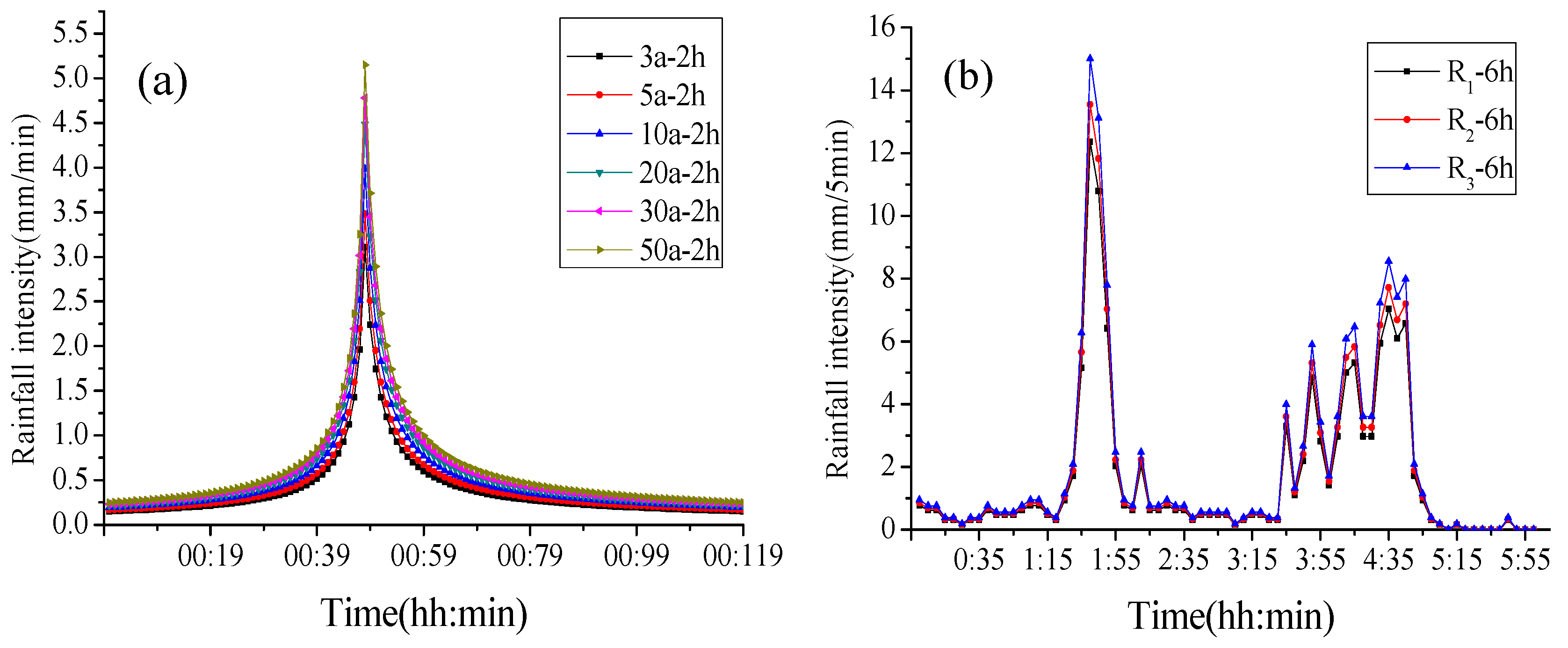
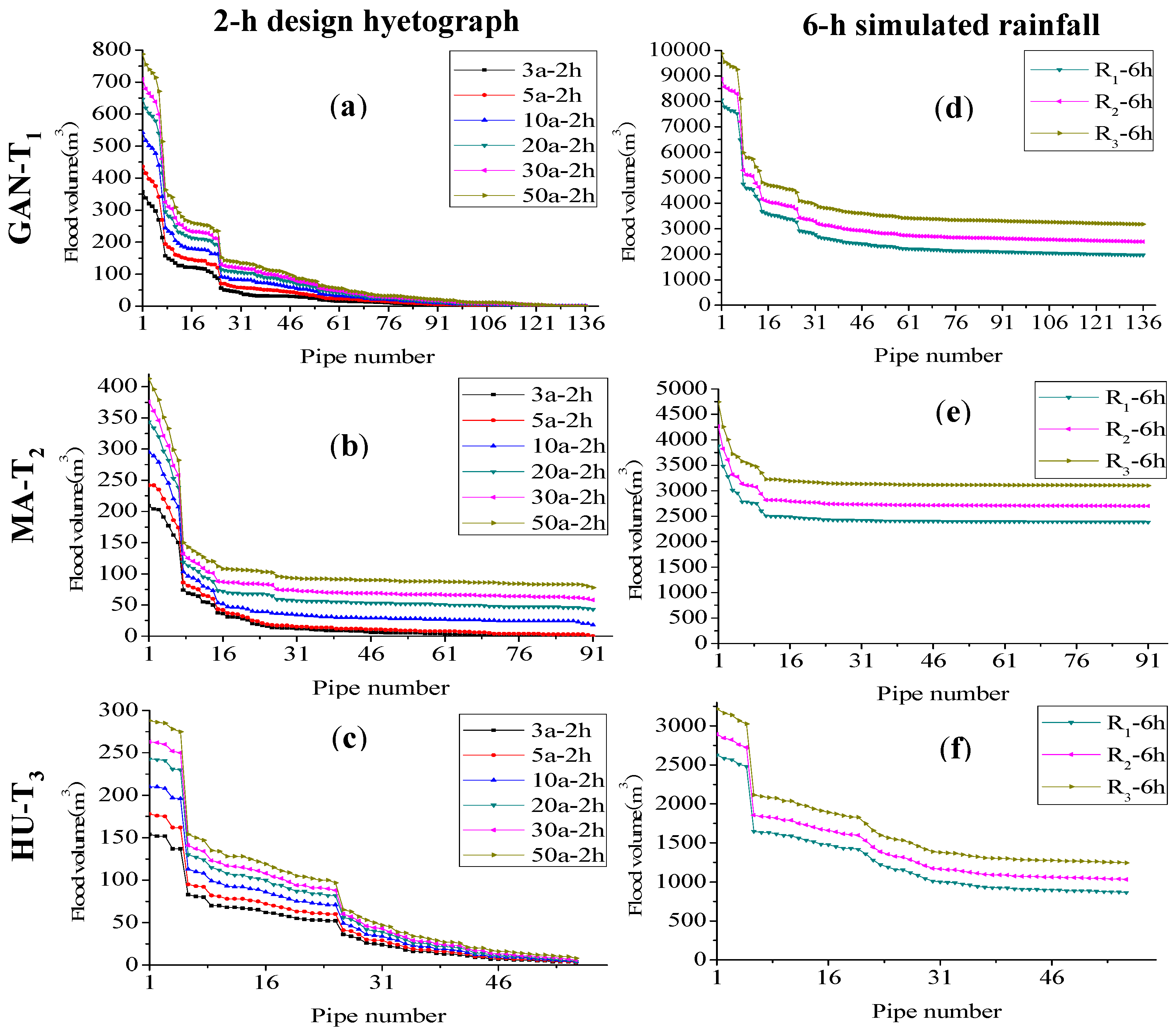
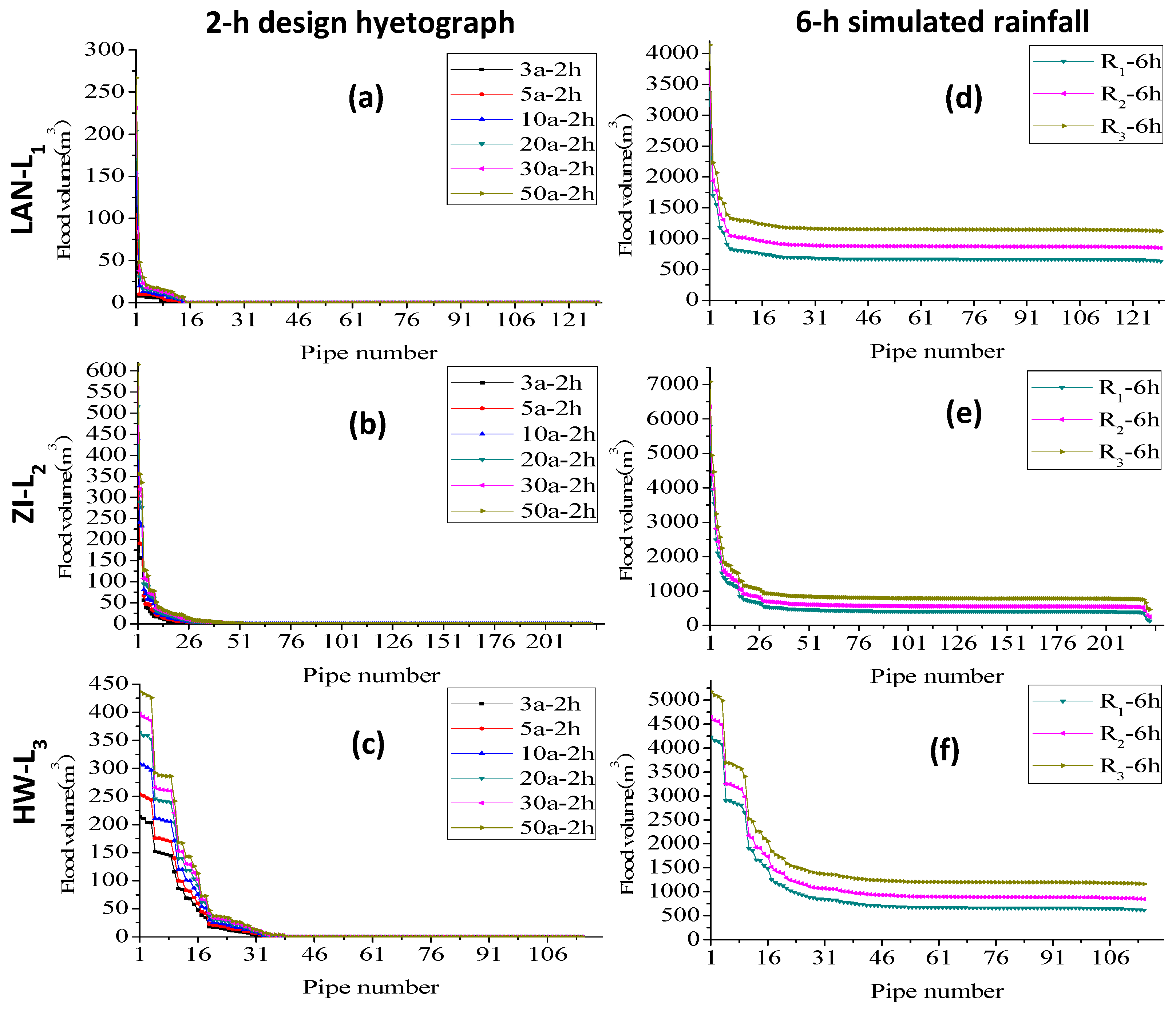

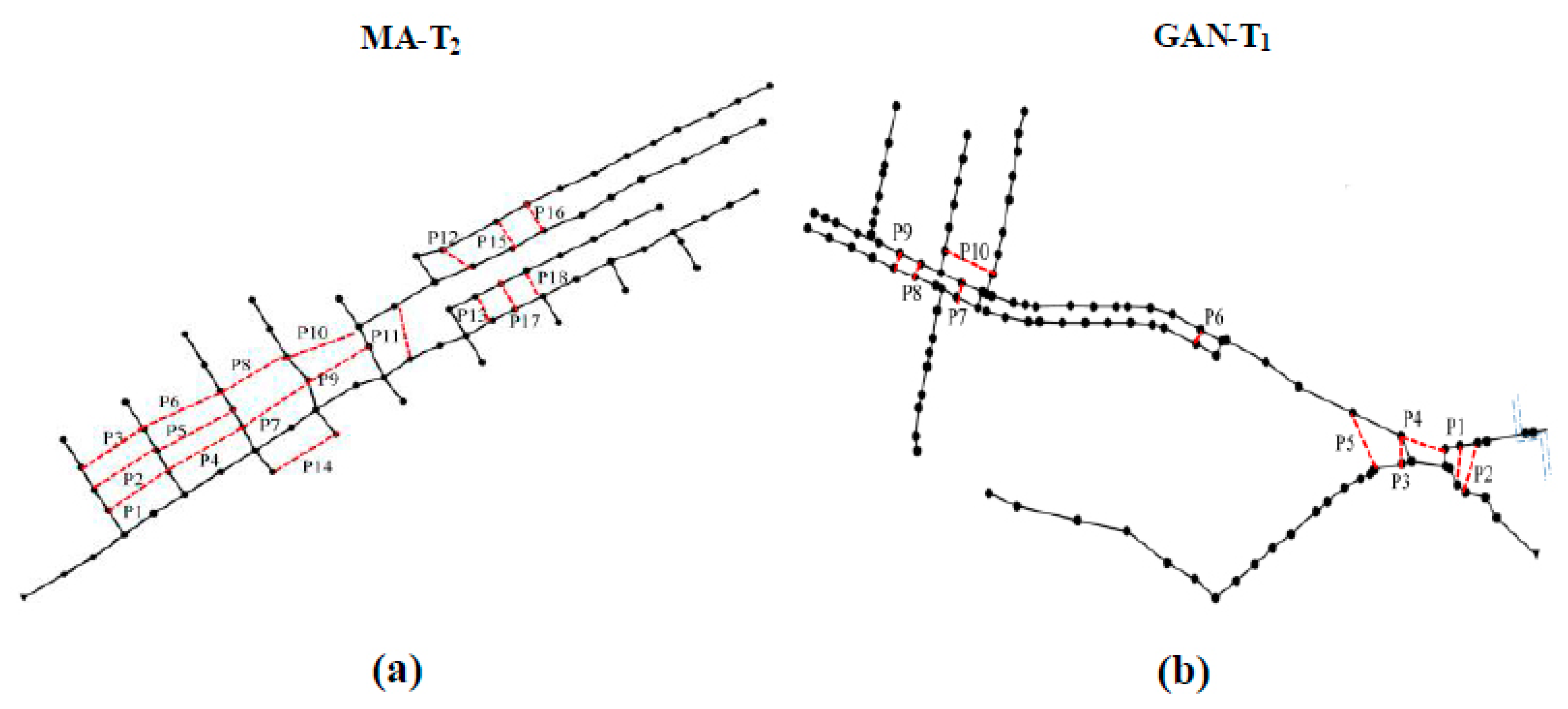
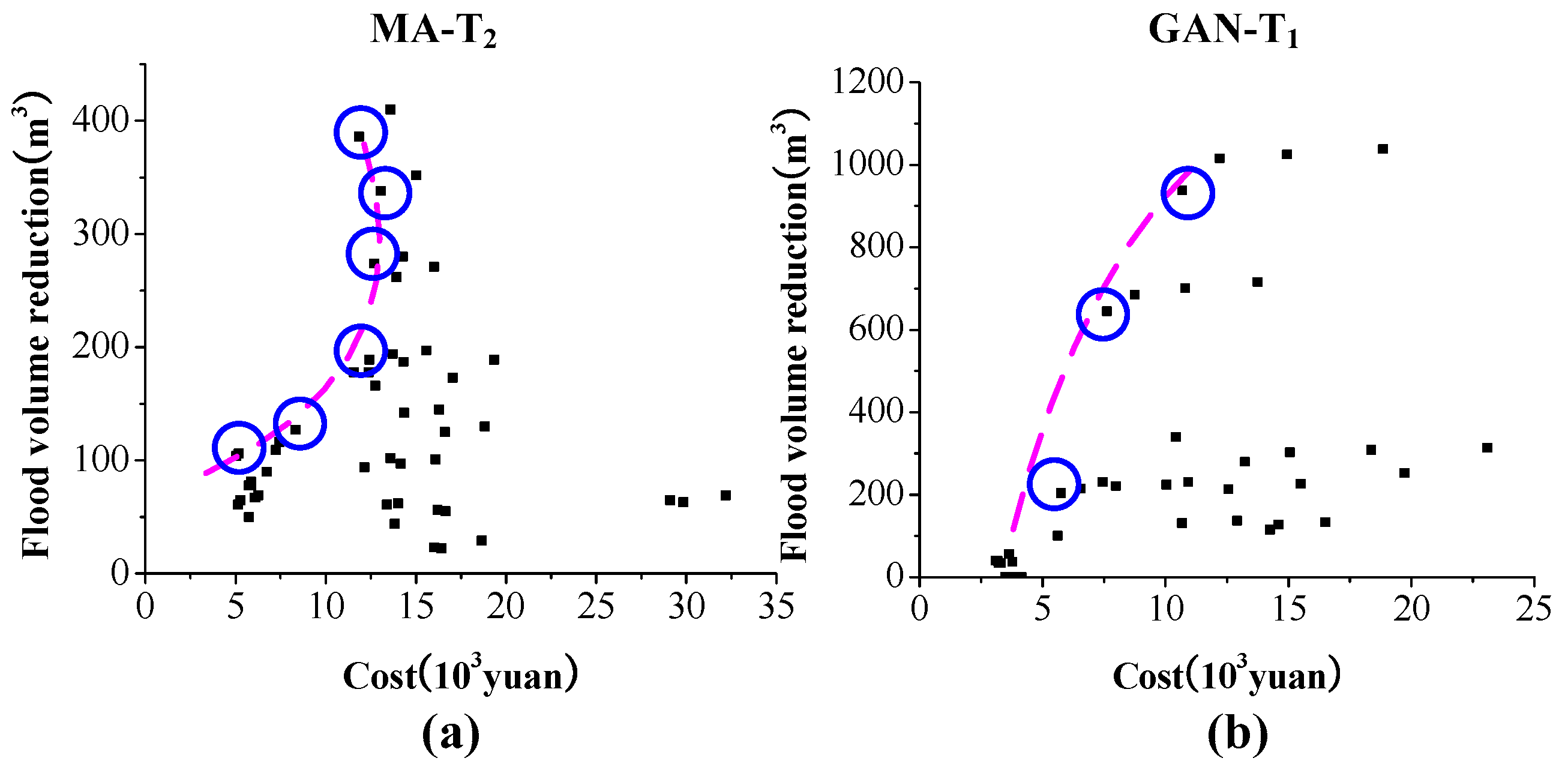
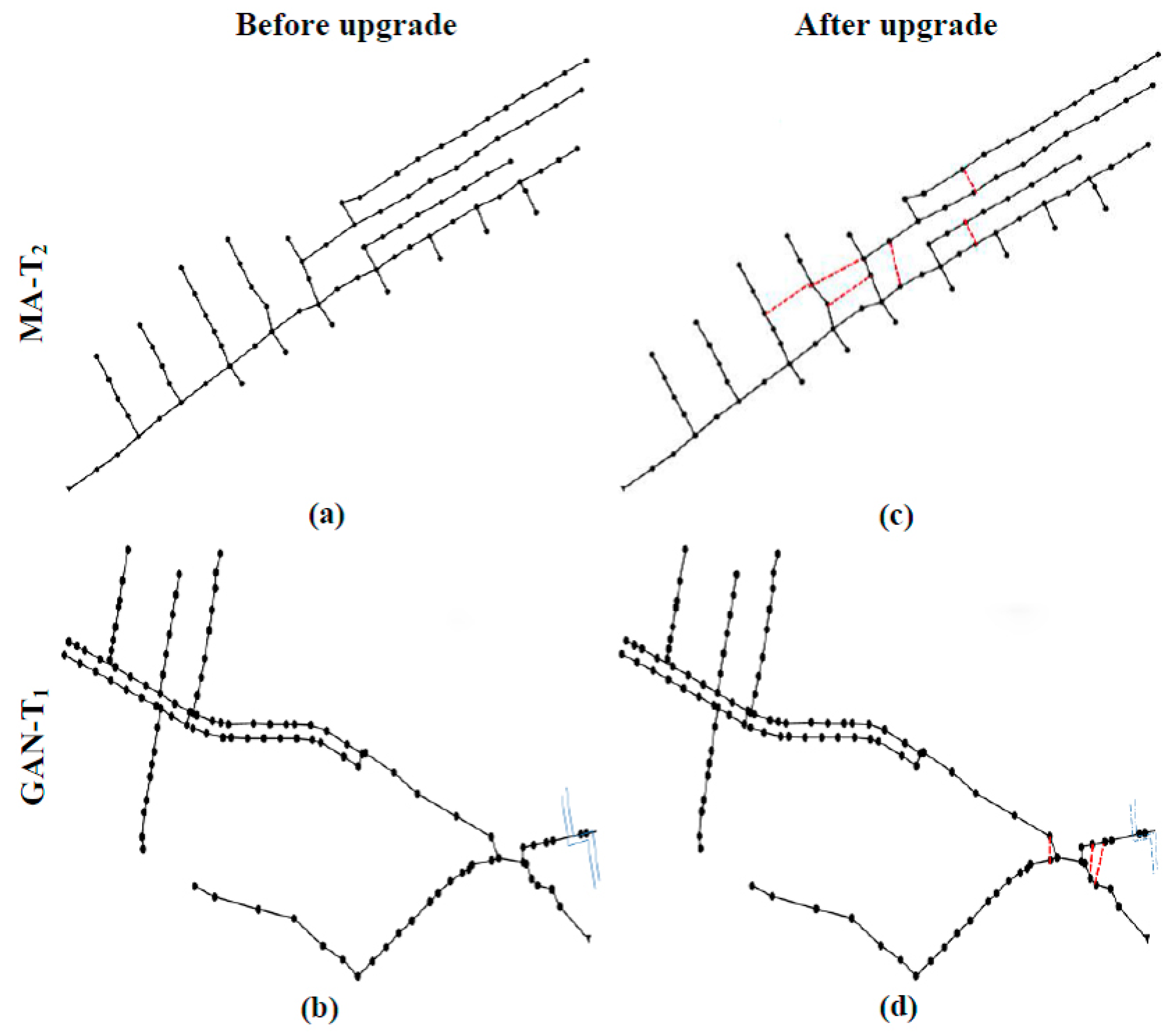
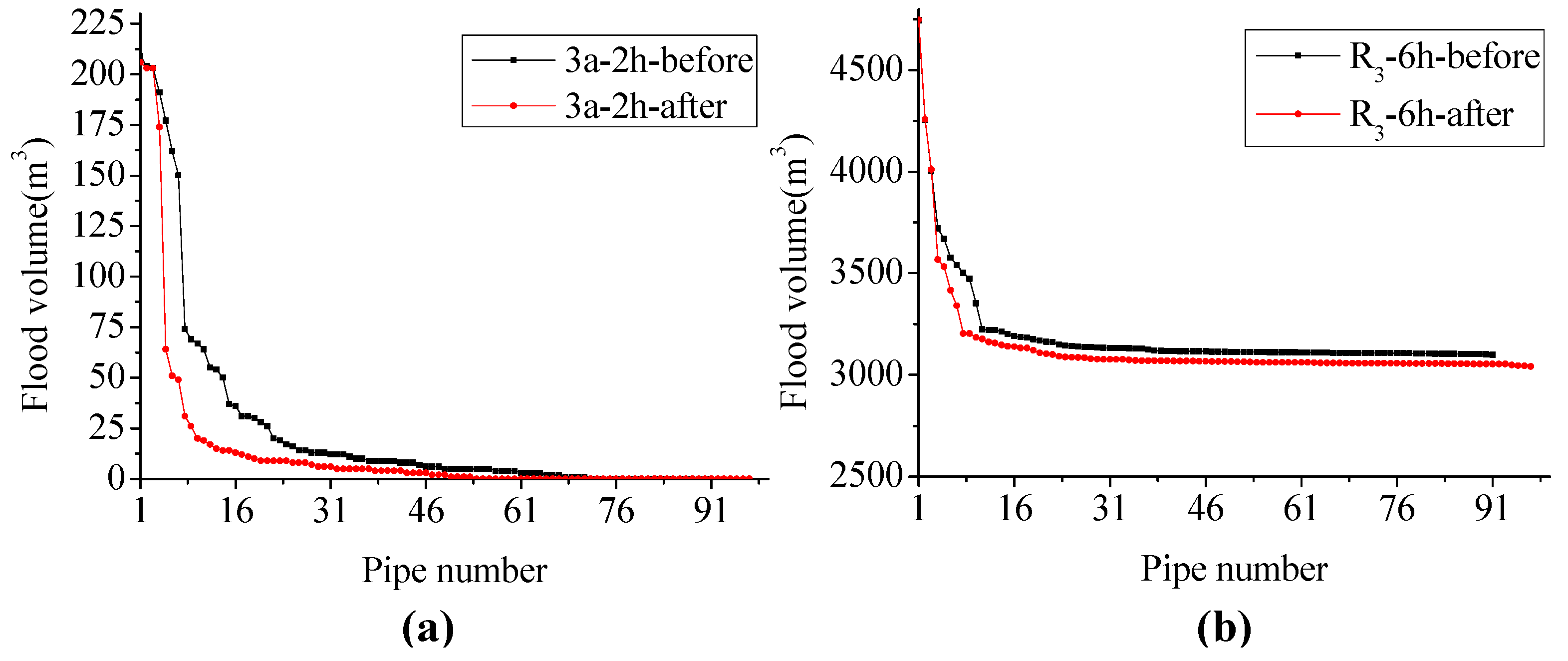
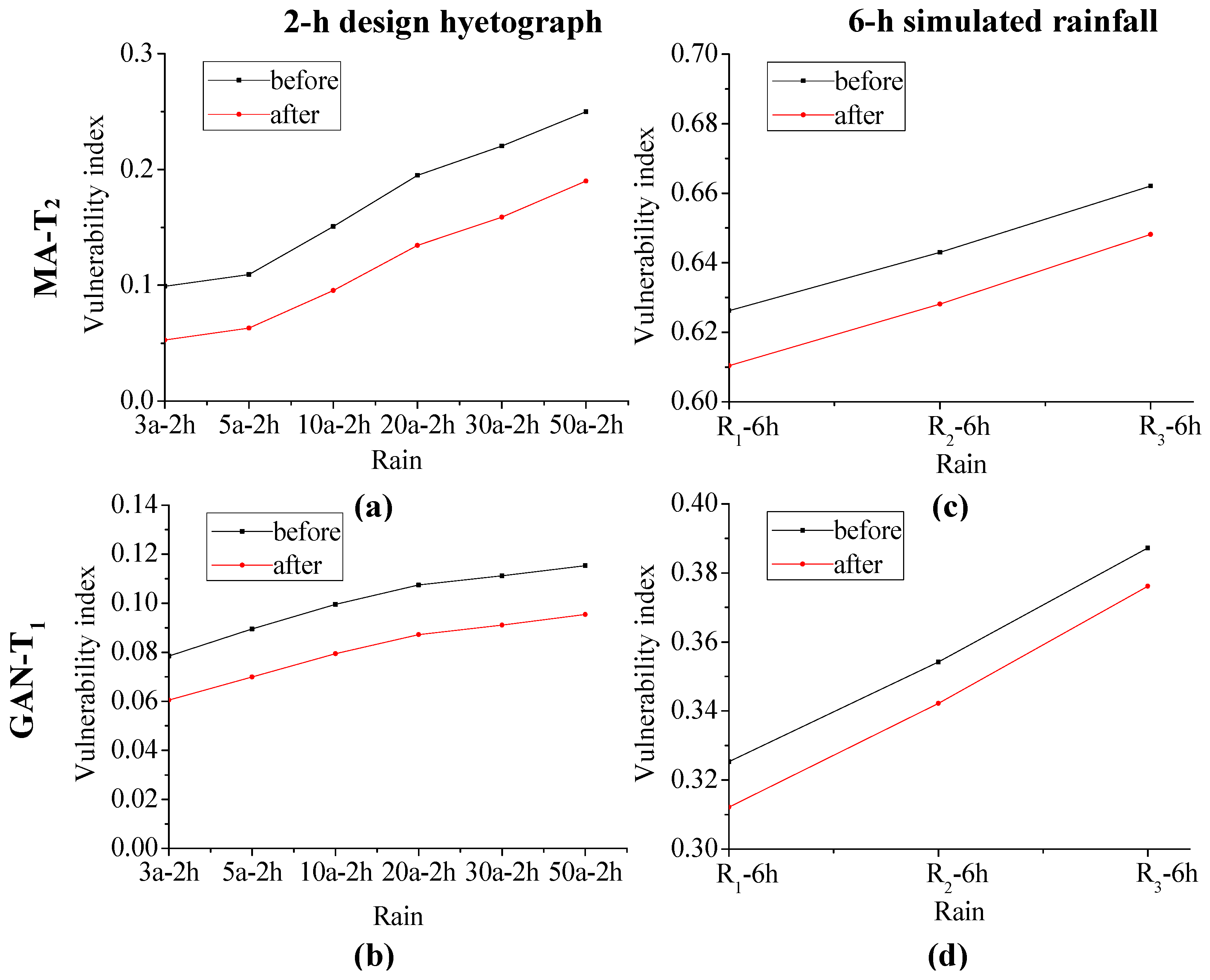
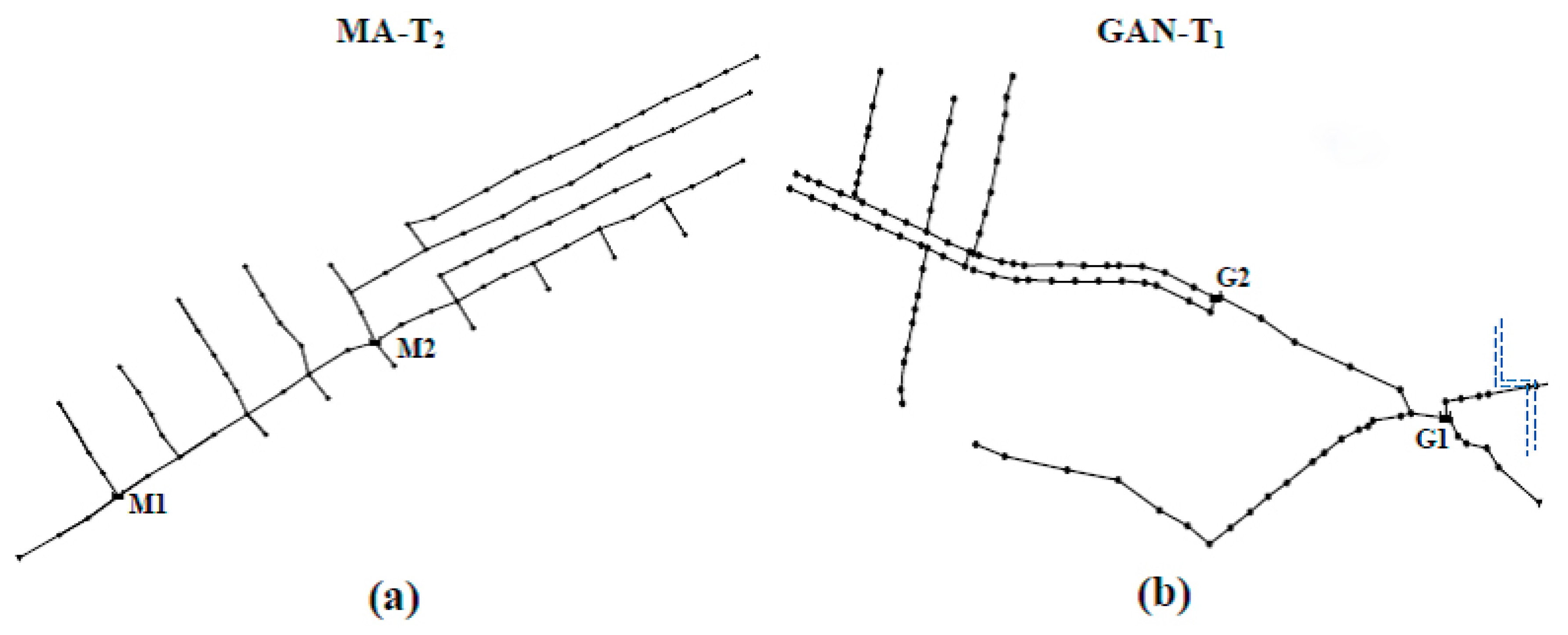

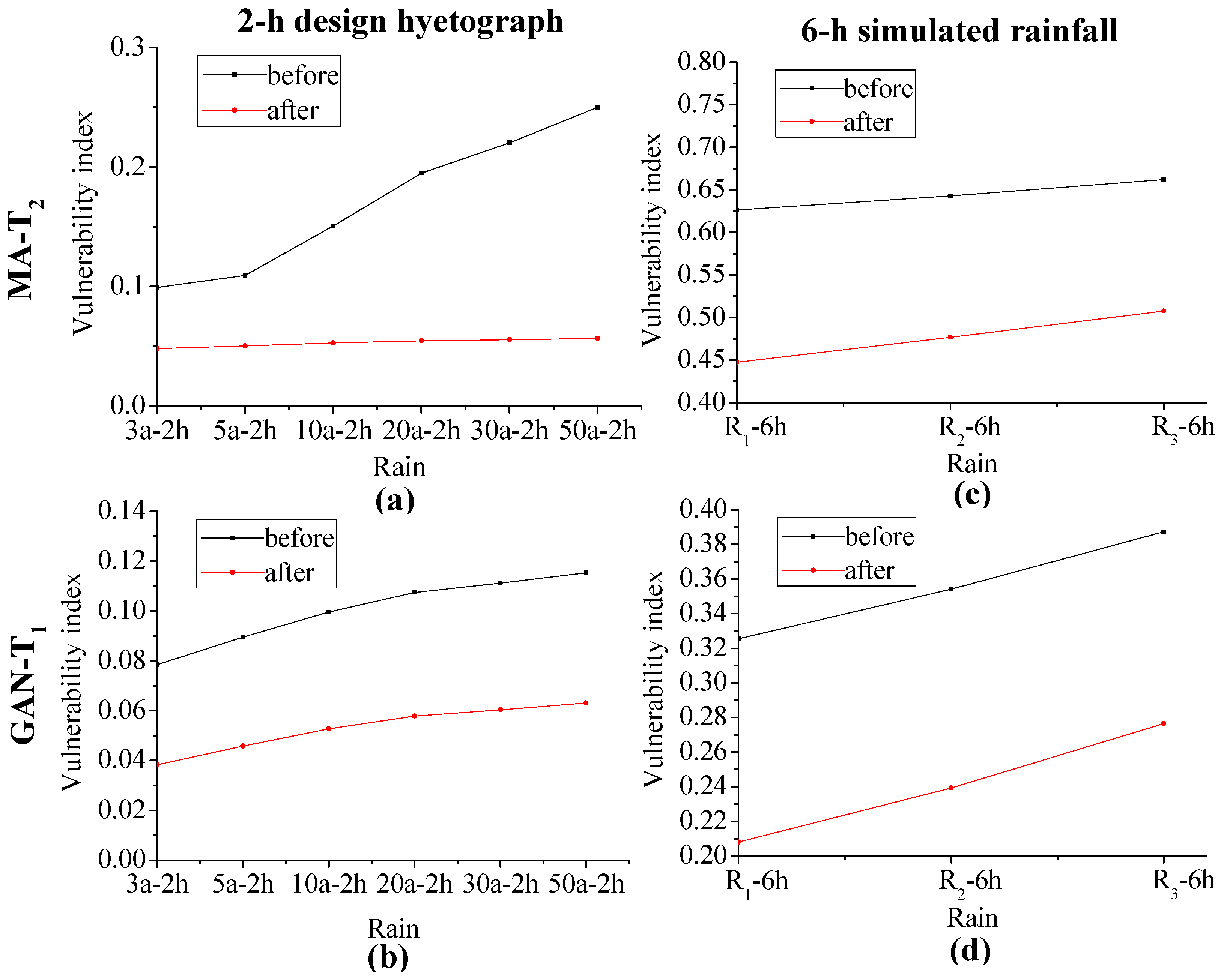
| Drainage System | No. of Nodes | No. of Pipes | No. of Outfalls | Catchment Area (ha) |
|---|---|---|---|---|
| GAN-T1 | 136 | 136 | 1 | 103.2 |
| MA-T2 | 83 | 91 | 1 | 48.8 |
| HU-T3 | 56 | 56 | 1 | 33.3 |
| LAN-L1 | 105 | 129 | 1 | 43.6 |
| ZI-L2 | 163 | 223 | 1 | 72.9 |
| HW-L3 | 103 | 115 | 1 | 53.7 |
© 2017 by the authors. Licensee MDPI, Basel, Switzerland. This article is an open access article distributed under the terms and conditions of the Creative Commons Attribution (CC BY) license ( http://creativecommons.org/licenses/by/4.0/).
Share and Cite
Zhang, C.; Wang, Y.; Li, Y.; Ding, W. Vulnerability Analysis of Urban Drainage Systems: Tree vs. Loop Networks. Sustainability 2017, 9, 397. https://doi.org/10.3390/su9030397
Zhang C, Wang Y, Li Y, Ding W. Vulnerability Analysis of Urban Drainage Systems: Tree vs. Loop Networks. Sustainability. 2017; 9(3):397. https://doi.org/10.3390/su9030397
Chicago/Turabian StyleZhang, Chi, Yuntao Wang, Yu Li, and Wei Ding. 2017. "Vulnerability Analysis of Urban Drainage Systems: Tree vs. Loop Networks" Sustainability 9, no. 3: 397. https://doi.org/10.3390/su9030397





